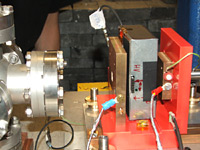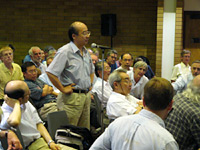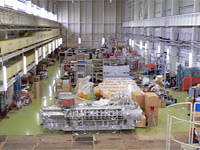 |
|
|
 |
FCAL’S Best Friends

Mechanical setup for irradiating the diamond sensors. |
The forward calorimeters in the future ILC detectors will be an extremely hostile environment, and to be able to make measurements, the detectors have to be able to take a lot without giving in. That's why the Forward Calorimeter Collaboration is testing all its options and has just come back from Darmstadt University's S-DALINAC - for Superconducting Darmstadt Linear Accelerator - with results on the radiation hardness of diamond sensors for the detector.
Forward calorimeters measure the energy of particles crossing them in the direction of the beams. The FCal Collaboration with its 10 institutes from around the world works on a calorimeter system consisting of a luminosity and a beam calorimeter, all of which can be used in any future ILC detector, independent of the concept from which they were born. Their performance depends on their radiation hardness: at the ILC we have to tackle a new phenomenon - beamstrahlung.
Read more...
-- Barbara Warmbein |
 |
|
|
 |
|
 |
RDR and DCR on Schedule at VLCW06

Nobu Toge asking a question during the closing plenary session at VLCW06. |
In closing out last week's Vancouver Linear Collider Workshop 2006, Global Design Effort Director Barry Barish declared that the Reference Design Report (RDR) and Detector Concept Report (DCR) are on track to be released in draft form in early 2007. "We have seen a lot of costing information, and we are still on track," he said.
Hosted jointly by the American Linear Collider Planning Group (ALCPG) and the GDE, nearly 300 participants met for a four-day workshop at the University of British Columbia in Vancouver, Canada. While some meeting participants rose early to take morning swims, the sublime views of the Canadian Rockies and the Pacific Ocean did not distract anyone from the tasks at hand: assess progress made toward writing a RDR and DCR, determine next steps for the ILC R&D program, and complete preliminary costing for the ILC.
Read more...
-- Elizabeth Clements |
 |
|
|
 |
From physicsweb
25 July 2006
Laser could create dark-matter particles
By the end of the year, physicists at the DESY laboratory in Germany may have caught a glimpse of an exotic dark-matter particle known as an axion.
Read more... |
|
From Science Magazine
21 July 2006
Europe Draws Up Road Map, With Added CLICs
European particle physicists last week laid out their priorities for the future in a document that gives top billing to the nearly completed Large Hadron Collider at CERN, the European particle physics lab...
Read more...
(Subscription required) |
|
|
 |
Building and Testing a String of Cryomodules - a Task for S2

Klystron Gallery in the Superconducting RF Test Facility under development at KEK |
An ambitious and crucial goal of the ILC R&D programme is to build and test a string of superconducting RF cryomodules that operate at or near the design gradient. Achieving such a milestone would help optimise the design and minimise the risks for full-scale production of the ILC main linac. Large and long-term R&D programmes aimed at this goal are getting underway at several of our laboratories. The GDE R&D Board has recognised the need for the GDE to provide guidance to these programmes - therefore it is forming a special task force called S2 that will be co-chaired by Hasan Padamsee (Cornell) and Tom Himel (SLAC).
Read more...
-- Barry Barish
Director's Corner Archive |
 |
|
|
 |
|
ILC Related Preprints
hep-ph/0607225
20 Jul 2006
Event-shape of dileptons plus missing energy at a linear collider as a SUSY/ADD discriminant
hep-ph/0607167
14 Jul 2006
Little Higgs model effects in gamma gamma to gamma gamma |
|

